
newspapers : 1951
| home | catalogue | history | references | appendix |
 |
surfresearch.com.au
newspapers : 1951 |
|
|
|
|
|
|
The
Herald
Melbourne, 2 January 1951, page 5. (Torquay) Miss Faye Osborne, of Elwood, Miss Gene Mew, of Carnegie, and Miss Annette Hampton, of Bendigo, rest against their gay surfboards as they talk with Miss Norma Eastwood. Trove 1951 'TORQUAY SURFERS', The Herald (Melbourne, Vic. : 1861 - 1954), 2 January, p. 5. , viewed 12 Sep 2019, http://nla.gov.au/nla.news-article248314391 |
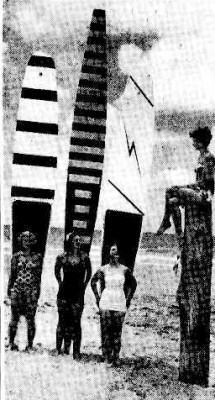 |
Judge Curlewis has grown up with the century
He is a
"Federation baby" who has lived 50 eventful years.
By HELEN
FRIZELL, staff reporter
District changes
Surfboard virtuoso
(Photographs)
THE BOY
ADRIAN
CURLEWIS at the age of nine.
This
picture was taken in London when Adrian was travelling
with his family.
In 1910
nearly all small boys were dressed in sailor suits by
their mothers.
IN SCHOOL
BLAZER, Adrian Curlewis posed for group picture of Shore's
rowing four.
The year
was 1919, when boys wore serious expressions and long
fringed scarves with their blazers.
THE MAN
IN 1945
Captain Curlewis returned home after three years in Changi
and on
the
Thailand railway as a member of the 8th Division.
TO-DAY,
at the age of 50, Adrian Curlewis is a judge of the New
South Wales District Court.
He has a fine record of achievement.
| The
Sunday Herald Sydney, 11 February 1951, page 13. SURFBOARD
WIN
CONSISTENT
Coogee surfboard rider Peter Wilson won the
metropolitan championship from a strong field at
Bondi yesterday.
Trove 1951 'SURFBOARD WIN', The Sunday Herald (Sydney, NSW : 1949 - 1953), 11 February, p. 13. (Sports Section), viewed 12 Sep 2019, http://nla.gov.au/nla.news-article18501952 |
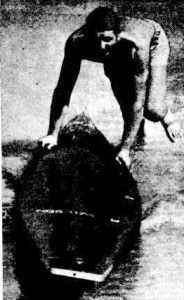 |
Byron Bay Surfer Takes Belt Title In Rousing Finish.
|
Brisbane
Telegraph
17 May 1951, page 30. NEW
AID TO SWIMMERS.
Novice surfers and still-water swimmers will be able to gain added assistance next summer with, a new "gadget" known as the "hand flipper". Sydney Ieg
flipper manufacturer, Mr. M. D. Turnbull,
thinks his new hand flipper will catch
on just as the leg
flippers have done in the past two
years.
As Mrs. Turnbull
illustrates in the picture above the hand
flipper is made of rubber and fits over the
hand.
Tests in Sydney have shown that it gives the swimmer much greater pull through the water, thereby increasing speed tremendously. Mass
production will begin before the summer and
special sizes will be produced for women and
children.
Turnbull
manufactured three sizes of leg flippers
last summer - junior, medium, and senior.
In the coming summer he will add a baby junior model with an adjustable strap. Trove 1951 'NEW AID TO SWIMMERS', Brisbane Telegraph (Qld. : 1948 - 1954), 17 May, p. 30. (CITY FINAL), viewed 02 Feb 2020, http://nla.gov.au/nla.news-article212274747 |
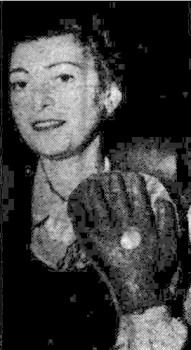 |
| The Sydney
Morning Herald 4 June 1951, page 1. WINTER
DID NOT WORRY THIS TRIO OF SURFBOARD RIDERS
Winter couldn't keep these three surfboard riders from the water at North Bondi yesterday. They are (left to right): Jim Rouse, Keith Goodall and Leo Mayhew. Trove 1951 'WINTER DID NOT WORRY THIS TRIO OF SURFBOARD RIDERS', The Sydney Morning Herald (NSW : 1842 - 1954), 4 June, p. 1. , viewed 31 Dec 2016, http://nla.gov.au/nla.news-article18213487 |
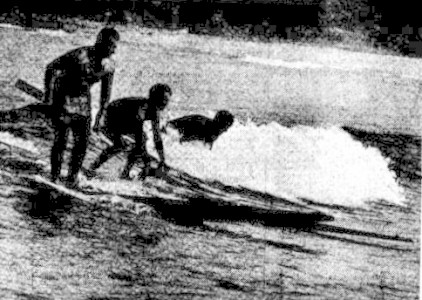 |
| The
Sunday Herald Sydney, 15 July 1951, page 3. Sydney Out of Doors On A Sunny Winter's Morning Pam Bass (second from left) took her surfboard out at Bondi, where she often has an early morning dip. http://nla.gov.au/nla.news-article18500444 |
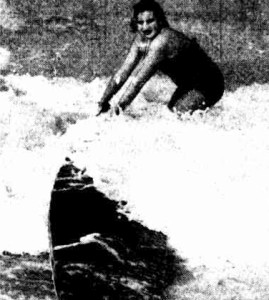 |
| Townsville
Daily Bulletin 13 August 1951, page 4. POWER:
ONE PORPOISE
A trained porpoise towing a surfboard with passengers - Pat Dale and a dog - in Florida (U.S.). The trainer of the
porpoise took only a few months to teach it to tow
surfboards, leap through a hoop and ring a bell.
Trove 1951 'POWER: ONE PORPOISE; ACTION OF CHAMPION.', Townsville Daily Bulletin (Qld. : 1907 - 1954), 13 August, p. 4. , viewed 31 Dec 2016, http://nla.gov.au/nla.news-article63380796 |
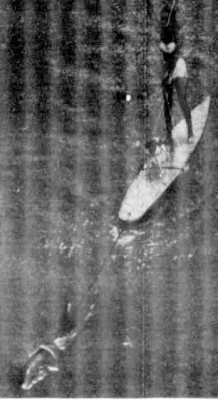 |
| The Sydney
Morning Herald 12 November 1951, page 3. RIDING THE BREAKERS AT NORTH
BONDI
Two surf board riders catch a wave to the beach at North Bondi yesterday afternoon. In the background thc sun is reflected off the bonnets of cars parked along the promenade. Trove 1951 'RIDING THE BREAKERS AT NORTH BONDI', The Sydney Morning Herald (NSW : 1842 - 1954), 12 November, p. 3. , viewed 31 Dec 2016, http://nla.gov.au/nla.news-article18238904 |
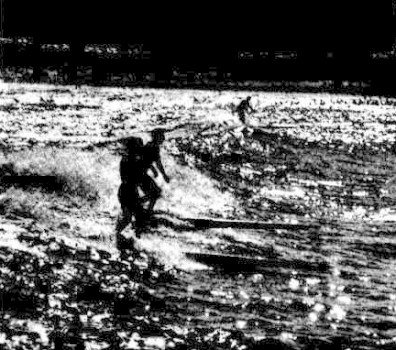 |
| The
Argus Melbourne, 17 December 1951, page 3. He
sailed on a surfboard . . . while the girls
marched past
SURF at St. Kilda on Saturday made life worth saving. And 200 boys and girls competent to do just that - paraded on the beach for the life-saving carnival in aid of the Southern Memorial Hospital. They came from eight bayside clubs, and put on an impressive march-past before competing in swimming and rescue events. Bruce Bowman (right), Black Rock lifesaver and beltman, sailed his surfboard and had a grandstand view of girls of the Half Moon Bay Life-saving Club (below) sand-marching their reel towards him. Trove 1951 'He sailed on a surfboard... while the girls marched past', The Argus (Melbourne, Vic. : 1848 - 1957), 17 December, p. 3. , viewed 31 Dec 2016, http://nla.gov.au/nla.news-article23098256 |
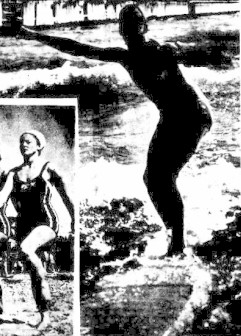 |
|
|
|
|
|

| home | catalogue | history | references | appendix |